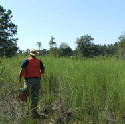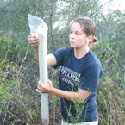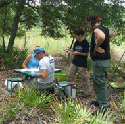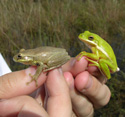Cuban Treefrog Research at UF
Morris Bridge Wellfield / Flatwoods Park
Long-Term Amphibian Monitoring Project
The Morris Bridge Wellfield / Flatwoods Wilderness Park Long-Term Amphibian Monitoring Project was the collaborative effort of Dr. Steve Johnson of the University of Florida, Dr. Todd Campbell of the University of Tampa and Kym Rouse Campbell of Environ Corp (formerly of Biological Research Associates). This group of biologists, technicians and student volunteers studied the distribution and impacts of the invasive Cuban Treefrog, (Osteopilus septentrionalis). The sixty-four wetlands used in this study had been greatly impacted by wellfield pumping to augment Tampa's water supply, which has in turn greatly affected treefrog populations. This site, on land owned by the Southwest Florida Water Management District, is managed by Hillsborough County as part of a series of public parks. The long term amphibian monitoring project used a threefold approach to study the effects Cuban Treefrogs are having on native treefrog populations already impacted by pumping.
Frog Call Surveys
Frog call surveys at each wetland during the summer breeding season measured calling activity by males. Call surveyors used standard methods (from North American Amphibian Monitoring Program), recording both the number of species calling and an estimate of the number of calling males.
Tadpole Surveys
Tadpole surveys at each wetland with water during the summer breeding season measured breeding activity and tadpole diversity. Dip nets were used to collect tadpoles from different areas within the wetland, then the tadpoles were identified, counted and measured. This provided information about the success of breeding amphibians.
Adult Monitoring Study
Last, but certainly not least, researchers used PVC pipe refuges installed around wetlands to attract treefrogs. Frogs were removed from the pipes, weighed, measured, and marked with elastomer -- basically, we gave them a "tattoo." The frogs were then released in the pipes where they were found, free to come and go as they pleased until the next pipe checking session. This sampling method can provide a lot of important information about these treefrogs, including growth rates and an estimate of population size. After we collected some baseline data, we removed Cuban Treefrogs from some sites, so that we couldan study the response of native treefrog populations and learn more about the impacts of Cuban Treefrogs and the posble benefits of removing them.
Published Study Results
Campbell, K.R., T.S. Campbell, and S.A. Johnson. 2010. The use of PVC refugia to evaluate spatial and temporal distributions of native and introduced treefrogs at a natural area in West-central Florida. Florida Scientist 73:78-88.



